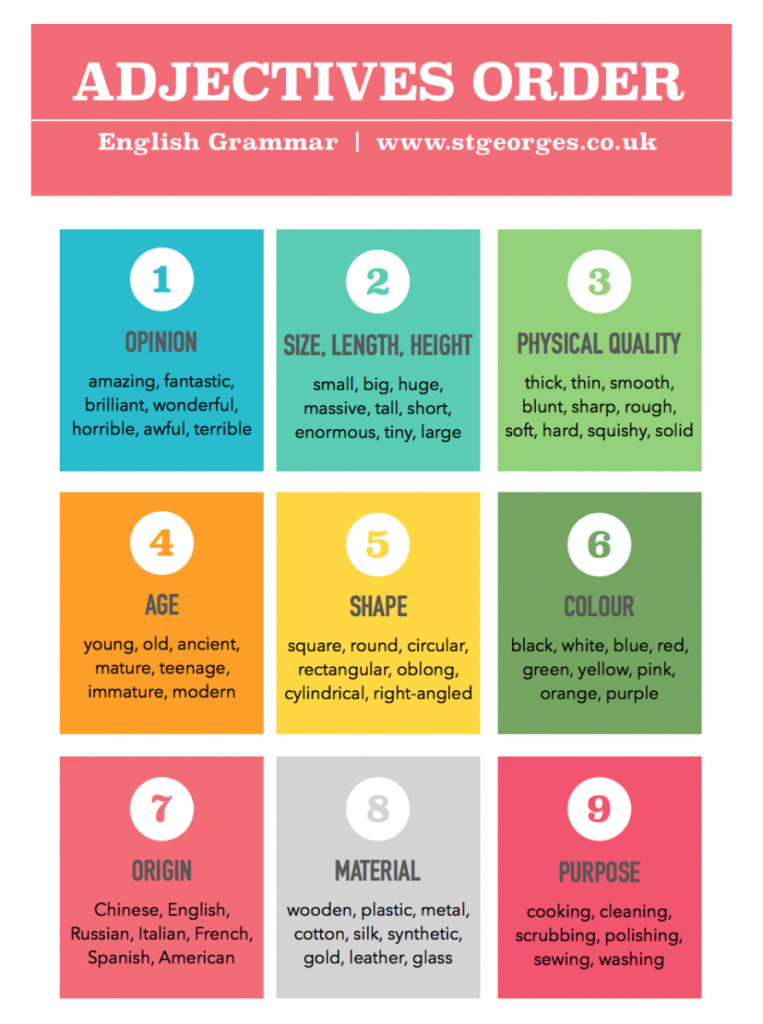
The Quirks of English Grammar: Understanding Adjective Order and More
Introduction to Adjective Order
The order of adjectives in English, while often perceived as arbitrary, adheres to a specific sequence that native speakers instinctively follow. Understanding this order is crucial for learners who wish to communicate clearly and effectively. The typical arrangement of adjectives includes categories such as opinion, size, age, shape, color, origin, material, and purpose. When adjectives are placed incorrectly, the meaning of a sentence can become obscure or completely altered. For example, consider the phrases “big red ball” and “red big ball.” The first is clear and descriptive, while the second sounds awkward and confusing, illustrating the necessity of mastering adjective order. This section sets the stage for deeper exploration into the intricacies of English grammar, emphasizing clarity in communication.

The Royal Order of Adjectives
In English, adjectives follow a royal order that helps convey meaning clearly and succinctly. The typical sequence is: opinion, size, age, shape, color, origin, material, and purpose. For instance, in the phrase “a beautiful large old round red American wooden dining table,” each adjective adheres to this order, creating a vivid image. Understanding each category is essential; for example, “beautiful” expresses an opinion, “large” denotes size, “old” indicates age, “round” describes shape, “red” provides color, “American” signifies origin, “wooden” reflects material, and “dining” reveals purpose. Misplacing these adjectives can lead to confusion, as in “a red round large old beautiful table,” which disrupts the expected flow. By mastering this sequence, learners can enhance clarity and coherence in their writing and speech.
Reduplication in English
Reduplication is a fascinating aspect of English that involves the repetition of sounds or words in a specific order, often for emphasis or rhythmic effect. Common examples include phrases like “ding dong” and “big bad,” where the first word sets up an expectation that the second word reinforces. This “front to back” rule creates a melody that is pleasing to the ear and makes these phrases memorable. Understanding the principles of reduplication can be particularly beneficial for language learners, as it highlights the importance of sound patterns in English. Moreover, reduplication showcases the playful nature of language, where sound and rhythm can convey meaning beyond mere definitions. By incorporating these elements into their vocabulary, learners can engage more effectively with the quirks of English.
The Role of Comedians in Language Critique
Comedians play a unique role in examining the idiosyncrasies of the English language, often highlighting its quirks and inconsistencies through humor. George Carlin, a master of observational comedy, frequently addressed the peculiarities of pronunciation, idiomatic expressions, and the inherent contradictions within the language. For example, Carlin’s commentary on phrases like “I could care less” reveals how language can often be illogical, yet widely accepted. By using humor, comedians engage audiences and encourage them to think critically about language. This exploration of English through a comedic lens not only entertains but also educates, making the subject more accessible and relatable. By embracing humor, learners can appreciate the complexities of English grammar and develop a deeper understanding of its rules.
Common Misunderstandings in English Usage
Misconceptions about English usage abound, often leading to confusion among learners. For instance, the difference between “healthy” and “healthful” can be subtle yet significant. “Healthy” refers to a state of good health, while “healthful” describes something that promotes health, such as a healthful diet. Another common misunderstanding is the phrase “the proof is in the pudding,” which is often misquoted. The original saying, “the proof of the pudding is in the eating,” emphasizes the importance of practical experience over mere speculation. By clarifying these misconceptions, learners can navigate the nuances of English more effectively, enhancing their communication skills. Understanding these subtleties not only aids in avoiding pitfalls but also enriches one’s grasp of the language.
The Complexity of Prepositional Verbs
Prepositional verbs present a unique challenge for English as a Second Language (ESL) learners. These verbs often have meanings that cannot be deduced from their individual components, making them particularly opaque. For example, the verb phrase “give up” means to stop trying, which is not apparent from “give” and “up.” Such phrases can lead to confusion, especially when learners attempt to substitute synonyms or alter components, resulting in nonsensical expressions. To navigate this complexity, it is essential for learners to familiarize themselves with common prepositional verbs and their meanings. Through practice and exposure, they can develop a better understanding of how these verbs function within the language, ultimately enhancing their communication skills.
The Evolution of English Grammar
The evolution of English grammar is a fascinating journey that reflects the language’s rich history and cultural influences. Over centuries, English has absorbed elements from various languages, including Latin, French, and Germanic tongues. This blending has led to the unique grammatical quirks and irregularities present in modern English. For example, the Great Vowel Shift in the 15th century dramatically changed the pronunciation of English vowels, contributing to the complexities of spelling and pronunciation we see today. Understanding this historical context allows learners to appreciate why certain grammatical rules exist or have changed over time. By recognizing the evolution of English, learners can gain insight into the language’s structure and its ongoing development, fostering a deeper connection to their studies.
Practical Tips for Language Learners
To master the intricacies of English grammar, learners can adopt several practical strategies. First, they should practice the royal order of adjectives through writing exercises, ensuring they become familiar with the correct sequence. Additionally, using flashcards to memorize common prepositional verbs can help solidify their meanings and applications. Engaging with comedy, such as watching stand-up routines, can provide a deeper understanding of linguistic quirks in a fun context. Moreover, learners should actively seek out resources, such as grammar guides and online exercises, to reinforce their knowledge. Regular practice and exposure to varied contexts will enhance their ability to recognize and apply grammatical rules effectively. By incorporating these tips into their learning routine, individuals can build confidence and improve their command of English.
Conclusion: Embracing the Oddities of English
In conclusion, the unique nature of English grammar, with its quirks and irregularities, offers both challenges and opportunities for learners. By embracing these oddities and understanding the rules that govern adjective order, reduplication, and more, learners can enhance their communication skills and gain confidence in their language use. The journey through English grammar may be filled with complexities, but it is also a rewarding experience that fosters growth and fluency. As learners continue to explore the language, they should remember that mastering these rules is a pathway to effective communication and deeper engagement with the rich tapestry of English. Continued learning and practice are essential in this journey, as they pave the way to fluency and understanding.
